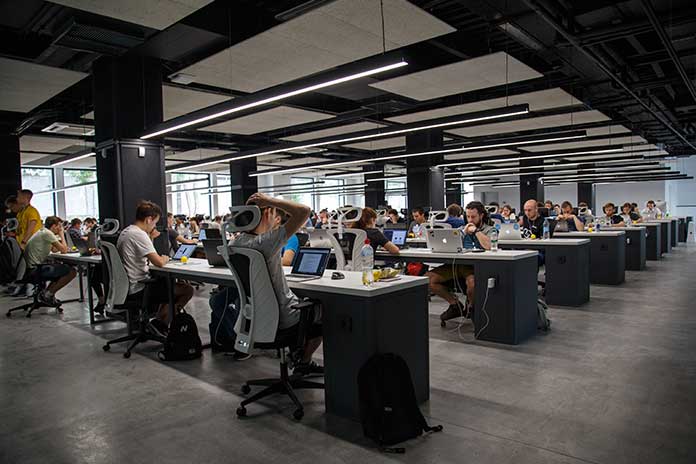The pandemic has both spawned new trends and accelerated existing ones. Today we see ourselves catapulted into a completely new HR landscape. The changes in the world of work in recent months have shown that the rapid adaptation to the pandemic conditions – above all safety distances and thus the move away from on-site meetings to virtual meetings or time-delayed forms of communication – as well as the temporary ad hoc solutions of the year 2020 Far from sufficient. But we can use the knowledge gained in 2020 to think about and implement bold and long-term changes. With it, we can take the future of work into our own hands and change it forever. Here are my top trends leaders should watch out for in 2022…
Trend 1: The Demand For Flexibility Is Unbroken
The focus on flexibility – be it through hybrid forms of work or complete remote work – will no longer go back to the time before the pandemic! Over the past year, employees have enjoyed the freedom of not being tied to a specific location. The outdated notions of presenteeism have finally been shown to be irrelevant. Companies that resist this change will have little chance of asserting themselves in the war for talent. A survey by polling firm Civey on behalf of EY Real Estate has revealed that a whopping 90% of people would like to work remotely, at least part-time or even full-time. There are also signs across Europe of a new wave of layoffs by employees who want to leave their jobs searching for more flexibility and meaning. This challenges companies to rethink and say goodbye forever to a corporate culture or working time strategy in which employees are measured by their presence from 9 a.m. to 5 p.m. (9-to-5).
I predict a dramatic increase in the number of companies rewarded for being more flexible in how and where employees work. And I also predict that even the most traditional industries will (have to) adapt.
Also Read: 6 Business & Technology Trends To Watch In 2022
Trend 2: The Future Of Talent Is Distributed
More knowledge workers have relocated in the past 20 months than ever before, and this trend will only increase. According to a Bitkom study , one in five employees (namely 21%) would move if most of the work could be done from home in the future. And that opens up great opportunities for employers who are flexible in their choice of work locations. Remote work, i.e., distributed work, has an enormous impact on talents who value mobility.
However, companies need to rethink and rethink their talent strategies and the collaboration tools needed to support employees in different locations to succeed. Recent research has found that video conferencing, cloud storage, file sharing, and simultaneous editing software have been critical to business continuity during the pandemic.
The same applies to the future: if all teams worldwide work more and more distributed, employees will increasingly need simple, easy-to-use document workflows that reduce friction losses, make all the information they need available at any time without any obstacles, and collaborate with others enormously.
Trend 3: The Rise Of Asynchronous Communication
Any change in the way you work requires a culture change. And to unlock the true flexibility of remote work, companies need to adopt an “asynchronous default.” When the pandemic first hit, “zoom fatigue” quickly gripped employees everywhere. Days of video calls sapped our energy and, most importantly, got in the way of meaningful work. Unnecessary meetings are one of the biggest disruptors to a productive and effective workday, and it’s up to all of us to change that. By encouraging our employees to remove all unnecessary meetings from their calendars and plan live conversations more consciously, They can more easily switch from “synchronized all day” to “asynchronous by default,” bringing more flexibility and focus to their day. However, the importance of live conversations remains. The magic teaches employees how to recognize when a quick zoom or phone call is (still) of value.
Ultimately, companies taking steps now to sync asynchronously and give talent more time and flexibility to shape their own lives will win in the medium and long term. I predict that neither a fixed place of work nor rigid working hours in the old 9-to-5 grid will have any chance in the future!
My conclusion: The Role Of The HR Or Personnel Department Has Changed Fundamentally
In recent months, the role of HR managers has changed significantly worldwide. Before Corona, HR was a necessary corporate department, often keeping things in order behind the scenes. But with the drastic change in the entire working world, the HR department also had to change. HR leaders have been the key players, the ones who have admirably navigated us through these challenging and unprecedented times. As a result, they finally got their well-deserved place at the executive table! Their role in the Corona crisis was arguably as crucial as that of CFOs during the 2008 recession – their leadership was needed at the highest level. Their value as strategic thinkers has been proven, their influence is recognized beyond HR. Even if the pandemic subsides, that place in leadership is likely to remain. In 2022, more and more HR leaders will be involved in business decisions across all areas, opening up a whole new world of opportunities for those willing to take charge.
Also Read: How COVID-19 Is Changing The Job Market For Software Engineers


